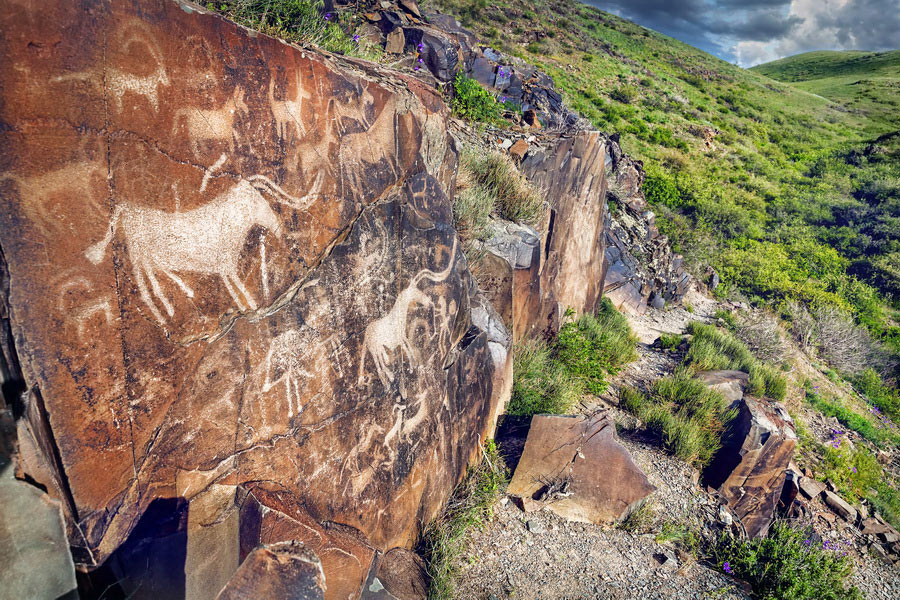
Tanbaly Petroglyphs - rock carvings protected by UNESCO
The Tanbaly petroglyphs were discovered for the first time in 1957 by the great archaeologist Anna Maximova. The history of the Tanbaly petroglyphs of the Bronze Age was published in 1958 in the national scientific journal "Journal of Science. Later the Tanbaly rock carvings were explored by the archaeologists Z. Samashev, A. Maryashev, A. Rogozhin and others. Archaeologist Alex Rogozhin set the period of application of the petroglyphs on the results of his research. He concluded that the time of petroglyphs was covering several time periods, ranging from the Bronze Age to the XIII-XIV centuries AD. He also tried to comprehend the significance of the petroglyphs in comparison with the images from the legend about the famous "Ogyz-name". In the Tanbaly in the fourth group there is the so-called 118-I plane, whose length is six meters and height is four meters. In the plane there are shown different drawings: six head creature with the torso of a man.
Now compare these petroglyphs describing images of the six sons of Ogyz Hagan. The first son of Ogyz Hagan was named after the Sun - the first petroglyphs depict a man over the head of whose there are the rays of the sun. Consequently this is the figure of the first son of Ogyz Hagan - Sun. The second petroglyphs depict a man whose head was consistent with a picture of the full moon, therefore, these petroglyphs depicted the second son of Ogyza – Moon. On the third petroglyphs on the man's head there is a little star, therefore, the third son of Ogyza - Star. The fourth petroglyphs depict a man whose head matches the character of the sky, respectively, the fourth son of Ogyza – Heaven. The head of the fifth person on the petroglyphs is round that probably means "high", therefore, these petroglyphs depicted one more son of Ogyza - Horus. The sixth petroglyphs depict a man whose head is inclined like a sea, hence, the figure shows the sixth son of Ogyza – Sea.
Below these figures one can see the images of the 12 dancing people and the legend says that Ogyz Hagan divided his territory into 12 zones, therefore, in the Tanbaly there are 12 dancing persons and maybe they embody these 12 zones. One of the gloomiest event in the history of Tanbaly petroglyphs happened in 1960 during the transportation of a rock with carvings to the museum of Almaty city which fell down and was broken into peaces. Its height was about three meters. In the legend about the "Ogyz-name" there is the description of Ogyz Hagan: "He was strong as a bull and big as a bear, his whole body was covered with the hair. If we compare this description to the petroglyphs some similarities with the description of the exterior Ogyz Hagan will be at 100% and therefore we can assume that the petroglyphs depict Ogyz Hagan himself. The mother's name of Ogyz Hagan was Ai Hagan. At the Tanbaly petroglyphs there is an image of Ai Hagan. These petroglyphs were discovered and restored by the archaeologist A. Rogozhin. Among the Tanbaly petroglyphs there is only one image of a woman in the whole growth and one more image of a woman giving birth to her child, respectively, according to the legend one woman is the mother of Ogyz Ai Hagan and the second one is his wife.
Now consider the image of a gray wolf who was the leader of the troops of Ogyz Hagan in the war campaigns. At the Tanbaly there are really two petroglyphs depicting a wolf and a horseman with a banner. According to the archaeologists the time of creating of one of them belongs to the middle Ages. These rock carvings are known to many people as the banner «jigit». The petroglyphs with a wolf were found at the time of documenting the rock carvings at the Tanbaly in 2005. They show a gray wolf with a man having a spear in his hand. And if you follow the legend about the "Ogyz-name" you will find that there the gray wolf was a young man who showed the way to the troops carrying the flag at the head of the troops and pointing them the right way.
Also it’s possible to say that if the history of Ogyz Hagan is depicted at the Tanbaly that probably means that he grew up in that area. And of course, this horseman grew brave because the she-wolf suckled him with her milk and educated him as well. That can assume us that the way was shown to the troops of Ogyz Hagan by that brave young rider who rode not on a horseback but the wolves. It is well known that the runic alphabets are related to the ancestors of the Kazakh people, evidenced by the Orkhon monuments. At the Tanbaly there are some runic inscriptions, the inscription of five letters in the fourth group. If you read it in accordance with the 13 options of the runic alphabet which was approved by the world scientists then you get the word "nerel" or "naret. We can assume that it was the appeal of Ogyz Hagan to his descendants and his people. Here the word "naret" means "abundance", therefore, on the rock carvings he wanted to wish wealth to his people.

